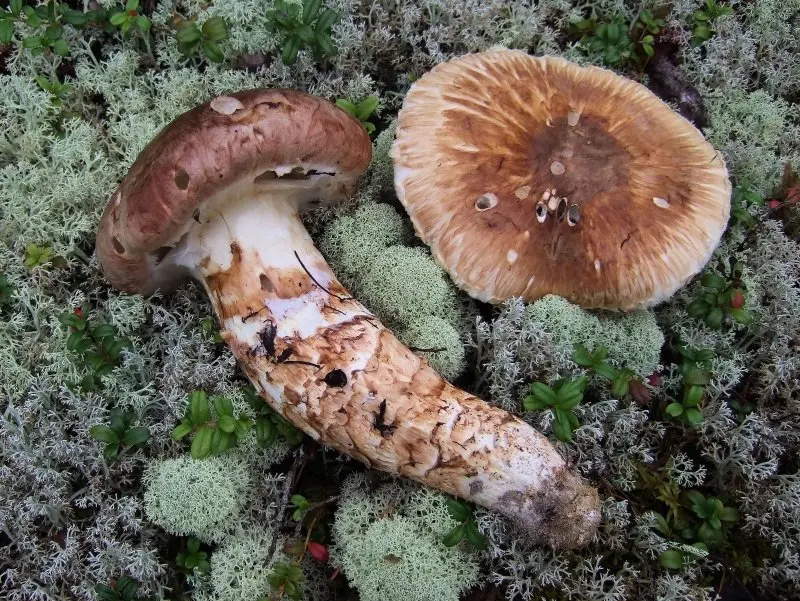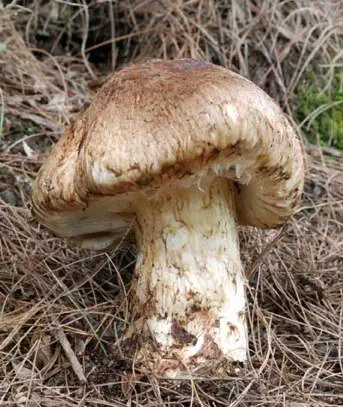Contents
Matsutake (Tricholoma matsutake)
- Division: Basidiomycota (Basidiomycetes)
- Subdivision: Agaricomycotina (Agaricomycetes)
- Class: Agaricomycetes (Agaricomycetes)
- Subclass: Agaricomycetidae (Agaricomycetes)
- Order: Agaricales (Agaric or Lamellar)
- Family: Tricholomataceae (Tricholomovye or Ryadovkovye)
- Genus: Tricholoma (Tricholoma or Ryadovka)
- Type: Tricholoma matsutake (Matsutake)
- Tricholoma nauseosum;
- Nauseous armory;
- Armillaria matsutake.

Matsutake (Tricholoma matsutake) is a fungus belonging to the genus Tricholome.
External description of the fungus
Matsutake (Tricholoma matsutake) has a fruiting body with a cap and stem. Its flesh is white in color, characterized by a pleasant spicy aroma, similar to the smell of cinnamon. The cap has a brown color, and in ripe and overripe mushrooms, its surface cracks and white mushroom pulp peeps through these cracks. In terms of its diameter, the cap of this mushroom is quite large, has a rounded-convex shape, a tubercle of large width is clearly visible on it. The surface of the cap is dry, initially off-white or brownish, smooth. Later, fibrous scales appear on it. The edges of the mushroom cap are slightly tucked up; fibers and a residual veil are often visible on them.
The hymenophore of the fruiting body is represented by a lamellar type. The plates are characterized by a cream or white color, which changes to brown with strong pressure on them or damage. Mushroom pulp is very thick and dense, exudes a pear-cinnamon aroma, tastes soft, leaves a bitter aftertaste.
The mushroom leg is quite thick and dense, its length can be from 9 to 25 cm, and the thickness is 1.5-3 cm. It expands to the base in the form of a club. Sometimes, on the contrary, it can narrow. It is characterized by an off-white color and an uneven brown fibrous ring. A powdery coating is noticeable above it, and the lower part of the mushroom leg is covered with walnut-brown fibrous scales.
The leg is characterized by a dark brown color and a large length. It is very difficult to get it out of the ground.
 Habitat and fruiting period
Habitat and fruiting period
The Matsutake mushroom, whose name is translated from Japanese as a pine mushroom, grows mainly in Asia, China and Japan, North America and Northern Europe. It grows near the foot of trees, often hiding under fallen leaves. A characteristic feature of the matsutake mushroom is its symbiosis with the roots of powerful trees growing in certain areas. So, for example, in North America, the fungus is a symbiosis with pine or fir, and in Japan – with red pine. Prefers to grow on infertile and dry soil, forms ring-type colonies. Interestingly, as this type of mushroom matures, the soil under the mycelium for some reason turns white. If suddenly the fertility of the soil increases, such an environment becomes unsuitable for the further growth of Matsutake (Tricholoma matsutake). This usually happens if the number of falling branches and old leaves increases.
Fruiting matsutake begins in September, and continues until October. On the territory of the Federation, this type of fungus is common in the Southern Urals, the Urals, the Far East and Primorye, Eastern and Southern Siberia.
Matsutake (Tricholoma matsutake) is a mycorrhizal species of oak and pine, found in oak-pine and pine forests. The fruiting bodies of the fungus are found only in groups.
Edibility
Matsutake mushroom (Tricholoma matsutake) is edible, and you can use it in any form, both raw and boiled, stewed or fried. The mushroom is characterized by high palatability, sometimes it is pickled or salted, but more often it is eaten fresh. Can be dried. The pulp of the fruiting body is elastic, and the taste is specific, as is the aroma (matsutake smells like resin). It is highly appreciated by gourmets. Matsutake can be dried.
Similar species, distinctive features from them
In 1999, scientists from Sweden, Danell and Bergius, conducted a study that made it possible to determine exactly that the Swedish mushroom Tricholoma nauseosum, previously considered to be just a similar species to Japanese matsutake, is actually the same variety of mushroom. The official results of comparative DNA allowed to significantly increase the number of exports of this mushroom variety from Scandinavia to Japan. And the main reason for such a demand for the product was its delicious taste and pleasant mushroom aroma.










 Habitat and fruiting period
Habitat and fruiting period